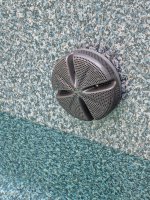- Nov 17, 2023
- 55
- Pool Size
- 21500
- Surface
- Vinyl
- Chlorine
- Salt Water Generator
- SWG Type
- Hayward Aqua Rite (T-15)
My pool is under construction and there are two fixtures I cannot identify. There are two skimmers, two return jets, and two diffusers? non-jet returns? that I don't recognize from other pools I've been in.
What are these? If they are returns, how do they differ from jets? Are there pros/cons? Is it to distribute heated water better?

What are these? If they are returns, how do they differ from jets? Are there pros/cons? Is it to distribute heated water better?







